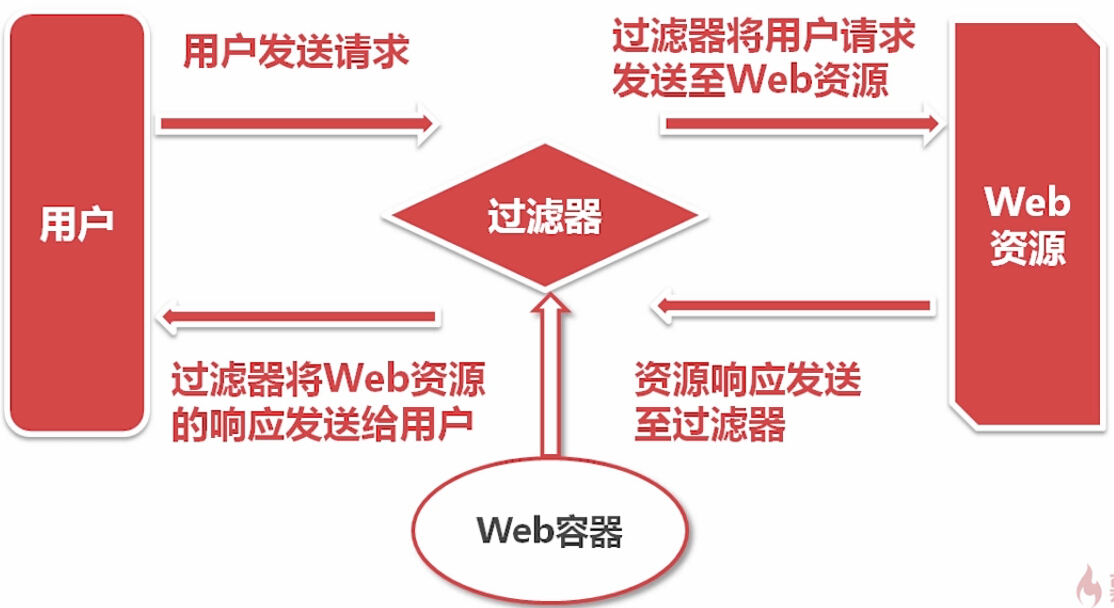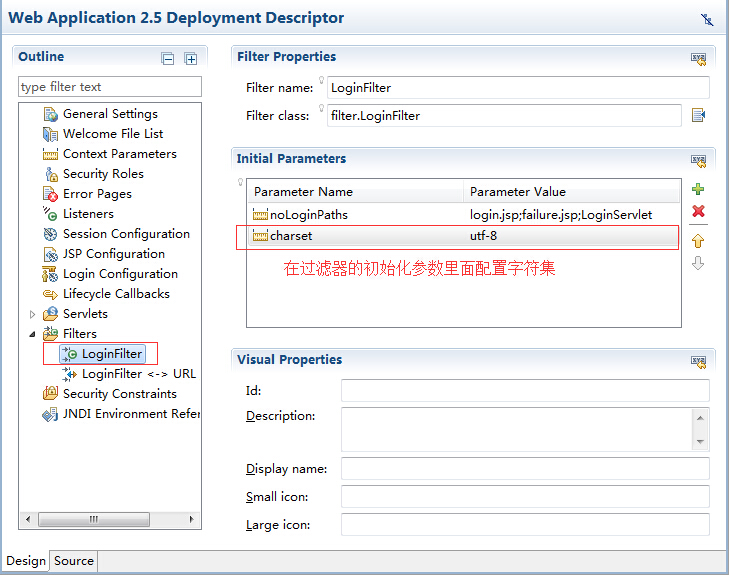过滤器简介
WEB过滤器是一个服务器端的组件,它可以截取用户端的请求与相应信息,并对这些信息过滤。
过滤器的工作原理和生命周期
在没有Web过滤器的情况下,用户直接访问服务器上的Web资源。但是如果存在过滤器,用户就不可以直接访问过滤器了。
Web容器启动的时候过滤器就已经启动了,用户的请求到达过滤器,过滤器判断用户的请求是否符合过滤规则,如果符合规则则将用户的请求发送给Web资源,Web资源将响应信息发送给过滤器,过滤器将Web资源的响应发送给用户。工作原理如下图所示:

过滤器的生命周期:

其中实例化方法在Web容器开始装载的时候就执行,初始化方法配置一些初始化参数,Web容器卸载(服务器关闭)的时候执行销毁方法。过滤方法会执行多次,其他方法只会执行一次。
第一个过滤器
1.创建一个类实现javax.servlet.Filter接口。需要实现该接口中的3个方法。

1 package filter; 2 3 import java.io.IOException; 4 5 import javax.servlet.Filter; 6 import javax.servlet.FilterChain; 7 import javax.servlet.FilterConfig; 8 import javax.servlet.ServletException; 9 import javax.servlet.ServletRequest; 10 import javax.servlet.ServletResponse; 11 12 public class FirstFilter implements Filter { 13 14 public void destroy() { 15 System.out.println("*********执行过滤器的销毁方法*******"); 16 17 } 18 19 public void doFilter(ServletRequest request, ServletResponse response, 20 FilterChain filterChain) throws IOException, ServletException { 21 System.out.println("*******开始执行过滤器的doFilter方法*********"); 22 filterChain.doFilter(request, response); 23 System.out.println("*******结束执行过滤器的doFilter方法**********"); 24 } 25 26 public void init(FilterConfig arg0) throws ServletException { 27 System.out.println("*******执行过滤器的初始化方法***********"); 28 29 } 30 31 }
- init(FilterConfig ):过滤器的初始化方法,Web容器创建过滤器之后将调用这个方法,在这个方法中可以读取web.xml中的过滤器参数。
- doFilter(ServletRequest,ServletResponse,FilterChain):完成实际的过滤操作,是过滤器的核心方法。当用户请求访问与过滤器相关联的URL的时候,Web容器将先调用过滤器的doFilter方法。FilterChain参数可以调用chain.doFilter方法【放行方法】,将请求传送给下一个过滤器(或者目标资源),或利用转发、重定向将请求转发给其他资源。
- destroy():Web容器在销毁过滤器实例前调用该方法,在这个方法中可以释放过滤器占用的资源。【大多数情况下用不到】
2.在web.xml中配置过滤器(和再web.xml中注册servlet类似)

在MyEclipse中提供了可视化的配置web.xml,如下图:


1 <?xml version="1.0" encoding="UTF-8"?> 2 <web-app version="2.5" 3 xmlns="http://java.sun.com/xml/ns/javaee" 4 xmlns:xsi="http://www.w3.org/2001/XMLSchema-instance" 5 xsi:schemaLocation="http://java.sun.com/xml/ns/javaee 6 http://java.sun.com/xml/ns/javaee/web-app_2_5.xsd"> 7 <display-name></display-name> 8 <welcome-file-list> 9 <welcome-file>index.jsp</welcome-file> 10 </welcome-file-list> 11 12 <!-- 配置过滤器开始 --> 13 <filter> 14 <filter-name>FirstFilter</filter-name> 15 <filter-class>filter.FirstFilter</filter-class> 16 </filter> 17 <filter-mapping> 18 <filter-name>FirstFilter</filter-name> 19 <url-pattern>/*</url-pattern> 20 </filter-mapping> 21 <!-- 配置过滤器结束 --> 22 23 </web-app>
在index.jsp中我们在控制台打印一行信息:"**********这是index.jsp*********";
将项目部署到服务器,启动服务器:

在Servlet容器装载的时候,执行过滤器的init方法,当用户请求页面的时候首先执行doFilter()方法,当Servlet容器卸载的时候执行过滤器的销毁方法。【注意:用户的请求先是到达过滤器并不是直接访问的Web资源】
还有一点需要注意:用户虽然能够改变用户请求的资源(例如:网上购物的时候点击“立即购买”,这个请求先要到达过滤器,如果过滤器检测到用户没有登录,就会将页面重定向到登陆页),但是过滤器不能直接处理用户的请求(过滤器不是Servlet),不能直接返回数据。
过滤器链
针对同一个用户请求(url-pattern),与之匹配的过滤器有多个,这个时候用户请求就会依次通过各个过滤器到达web资源。


新建2个过滤器:

1 package filter; 2 3 import java.io.IOException; 4 5 import javax.servlet.Filter; 6 import javax.servlet.FilterChain; 7 import javax.servlet.FilterConfig; 8 import javax.servlet.ServletException; 9 import javax.servlet.ServletRequest; 10 import javax.servlet.ServletResponse; 11 12 public class FirstFilter implements Filter { 13 14 public void destroy() { 15 System.out.println("*********过滤器1----->销毁方法*******"); 16 17 } 18 19 public void doFilter(ServletRequest request, ServletResponse response, 20 FilterChain filterChain) throws IOException, ServletException { 21 System.out.println("*******开始执行过滤器1----->doFilter方法*********"); 22 filterChain.doFilter(request, response); 23 System.out.println("*******结束执行过滤器1----->doFilter方法**********"); 24 } 25 26 public void init(FilterConfig arg0) throws ServletException { 27 System.out.println("*******执行过滤器1------>初始化方法***********"); 28 29 } 30 31 }

1 package filter; 2 3 import java.io.IOException; 4 5 import javax.servlet.Filter; 6 import javax.servlet.FilterChain; 7 import javax.servlet.FilterConfig; 8 import javax.servlet.ServletException; 9 import javax.servlet.ServletRequest; 10 import javax.servlet.ServletResponse; 11 12 public class SecondFilter implements Filter { 13 14 public void destroy() { 15 System.out.println("*********过滤器2----->销毁方法*******"); 16 } 17 18 public void doFilter(ServletRequest request, ServletResponse response, 19 FilterChain filterChain) throws IOException, ServletException { 20 System.out.println("*******开始执行过滤器2----->doFilter方法*********"); 21 filterChain.doFilter(request, response); 22 System.out.println("*******结束执行过滤器2----->doFilter方法**********"); 23 } 24 25 public void init(FilterConfig arg0) throws ServletException { 26 System.out.println("*******执行过滤器2------>初始化方法***********"); 27 } 28 29 }
在web.xml中配置两个过滤器(第一个过滤器在前面,两个过滤器都匹配index.jsp)

1 <?xml version="1.0" encoding="UTF-8"?> 2 <web-app version="2.5" 3 xmlns="http://java.sun.com/xml/ns/javaee" 4 xmlns:xsi="http://www.w3.org/2001/XMLSchema-instance" 5 xsi:schemaLocation="http://java.sun.com/xml/ns/javaee 6 http://java.sun.com/xml/ns/javaee/web-app_2_5.xsd"> 7 <display-name></display-name> 8 <welcome-file-list> 9 <welcome-file>index.jsp</welcome-file> 10 </welcome-file-list> 11 12 <!-- 配置过滤器开始 --> 13 <!-- 过滤器1 --> 14 <filter> 15 <filter-name>FirstFilter</filter-name> 16 <filter-class>filter.FirstFilter</filter-class> 17 </filter> 18 <filter-mapping> 19 <filter-name>FirstFilter</filter-name> 20 <url-pattern>/index.jsp</url-pattern> 21 </filter-mapping> 22 <!-- 过滤器2 --> 23 <filter> 24 <filter-name>SecondFilter</filter-name> 25 <filter-class>filter.SecondFilter</filter-class> 26 </filter> 27 <filter-mapping> 28 <filter-name>SecondFilter</filter-name> 29 <url-pattern>/index.jsp</url-pattern> 30 </filter-mapping> 31 <!-- 配置过滤器结束 --> 32 33 </web-app>
在index.jsp中我们打印如下的一句话: System.out.println("******** 这是index.jsp,处理过程完成 *********");
运行结果:

过滤器的分类:
Servlet 2.5中将过滤器分为4种,如下图所示:

1.REQUEST过滤器
新建一个过滤器FirstFilter(在web.xml中配置两个过滤地址index.jsp和main.jsp):

1 <?xml version="1.0" encoding="UTF-8"?> 2 <web-app version="2.5" 3 xmlns="http://java.sun.com/xml/ns/javaee" 4 xmlns:xsi="http://www.w3.org/2001/XMLSchema-instance" 5 xsi:schemaLocation="http://java.sun.com/xml/ns/javaee 6 http://java.sun.com/xml/ns/javaee/web-app_2_5.xsd"> 7 <display-name></display-name> 8 <welcome-file-list> 9 <welcome-file>index.jsp</welcome-file> 10 </welcome-file-list> 11 12 <!-- 配置过滤器开始 --> 13 <filter> 14 <filter-name>FirstFilter</filter-name> 15 <filter-class>filter.FirstFilter</filter-class> 16 </filter> 17 <filter-mapping> 18 <filter-name>FirstFilter</filter-name> 19 <url-pattern>/index.jsp</url-pattern> 20 <dispatcher>REQUEST</dispatcher> 21 </filter-mapping> 22 <filter-mapping> 23 <filter-name>FirstFilter</filter-name> 24 <url-pattern>/main.jsp</url-pattern> 25 <dispatcher>REQUEST</dispatcher> 26 </filter-mapping> 27 <!-- 配置过滤器结束 --> 28 29 </web-app>
在FirstFilter的doFilter方法中将页面重定向到main.jsp

1 package filter; 2 3 import java.io.IOException; 4 5 import javax.servlet.Filter; 6 import javax.servlet.FilterChain; 7 import javax.servlet.FilterConfig; 8 import javax.servlet.ServletException; 9 import javax.servlet.ServletRequest; 10 import javax.servlet.ServletResponse; 11 import javax.servlet.http.HttpServletRequest; 12 import javax.servlet.http.HttpServletResponse; 13 14 public class FirstFilter implements Filter { 15 16 public void destroy() { 17 System.out.println("*********过滤器1----->销毁方法*******"); 18 19 } 20 21 public void doFilter(ServletRequest request, ServletResponse response, 22 FilterChain filterChain) throws IOException, ServletException { 23 24 HttpServletRequest req = (HttpServletRequest) request; 25 HttpServletResponse res = (HttpServletResponse) response; 26 27 System.out.println("*******开始执行过滤器1----->doFilter方法*********"); 28 res.sendRedirect(req.getContextPath() + "/main.jsp");//重定向 29 System.out.println("*******结束执行过滤器1----->doFilter方法**********"); 30 } 31 32 public void init(FilterConfig arg0) throws ServletException { 33 System.out.println("*******执行过滤器1------>初始化方法***********"); 34 35 } 36 37 }
启动服务器:


当我们访问index.jsp的时候,过滤器将页面重定向到main.jsp——相当于我们又重新请求了main.jsp,main.jsp又会遇到过滤器,如此页面不停重定向到main.jsp,产生了死循环不会输出任何内容!
换一种方式,我们在过滤器中使用服务器内部转发的方式将页面转发到main.jsp(main.jsp向页面打印"这是main.jsp")。

1 package filter; 2 3 import java.io.IOException; 4 5 import javax.servlet.Filter; 6 import javax.servlet.FilterChain; 7 import javax.servlet.FilterConfig; 8 import javax.servlet.ServletException; 9 import javax.servlet.ServletRequest; 10 import javax.servlet.ServletResponse; 11 import javax.servlet.http.HttpServletRequest; 12 import javax.servlet.http.HttpServletResponse; 13 14 public class FirstFilter implements Filter { 15 16 public void destroy() { 17 System.out.println("*********过滤器1----->销毁方法*******"); 18 19 } 20 21 public void doFilter(ServletRequest request, ServletResponse response, 22 FilterChain filterChain) throws IOException, ServletException { 23 24 HttpServletRequest req = (HttpServletRequest) request; 25 HttpServletResponse res = (HttpServletResponse) response; 26 27 System.out.println("*******开始执行过滤器1----->doFilter方法*********"); 28 req.getRequestDispatcher("main.jsp").forward(request, response);//使用服务器内部转发 29 System.out.println("*******结束执行过滤器1----->doFilter方法**********"); 30 } 31 32 public void init(FilterConfig arg0) throws ServletException { 33 System.out.println("*******执行过滤器1------>初始化方法***********"); 34 35 } 36 37 }
运行结果:

2.FORWARD过滤器
将main.jsp的过滤规则改为FORWARD。
1 …… 2 <filter-mapping> 3 <filter-name>FirstFilter</filter-name> 4 <url-pattern>/main.jsp</url-pattern> 5 <dispatcher>FORWARD</dispatcher> 6 </filter-mapping> 7 ……
重新访问index.jsp

3.INCLUDE过滤器
INCLUDE和FORWARD过滤器的使用类似,对应的jsp动作是include。
4.ERROR过滤器
例如我们访问一个错误的页面时,系统会给出一个错误,用户看不懂这个错误是什么概念——我们需要给出一些人性化的提示。
以下是没有在web.xml中配置错误页,用户访问一个不存在的页面:

在web.xml中配置错误页:

1 <?xml version="1.0" encoding="UTF-8"?> 2 <web-app version="2.5" 3 xmlns="http://java.sun.com/xml/ns/javaee" 4 xmlns:xsi="http://www.w3.org/2001/XMLSchema-instance" 5 xsi:schemaLocation="http://java.sun.com/xml/ns/javaee 6 http://java.sun.com/xml/ns/javaee/web-app_2_5.xsd"> 7 <display-name></display-name> 8 <welcome-file-list> 9 <welcome-file>index.jsp</welcome-file> 10 </welcome-file-list> 11 12 <!-- 配置错误页面 --> 13 <error-page> 14 <error-code>404</error-code> 15 <location>/error.jsp</location> 16 </error-page> 17 18 </web-app>
在web.xml中配置404错误的页面为error.jsp则当用户访问一个不存在的页面时将会将error.jsp中的内容输出(以人性化的方式提示用户):

当页面出现错误或者异常的时候,ERROR过滤器可以将错误或者异常捕捉到,系统会记录下错误的信息,程序员就可以查找错误的来源。
新建一个ErrorFilter,并在web.xml中进行如下配置:

1 <!-- 配置错误页面 --> 2 <error-page> 3 <error-code>404</error-code> 4 <location>/error.jsp</location> 5 </error-page> 6 …… 7 <filter> 8 <filter-name>ErrorFilter</filter-name> 9 <filter-class>filter.ErrorFilter</filter-class> 10 </filter> 11 <filter-mapping> 12 <filter-name>ErrorFilter</filter-name> 13 <url-pattern>/error.jsp</url-pattern> 14 <dispatcher>ERROR</dispatcher> 15 </filter-mapping> 16 ……
错误过滤器ErrorFilter

1 package filter; 2 3 import java.io.IOException; 4 5 import javax.servlet.Filter; 6 import javax.servlet.FilterChain; 7 import javax.servlet.FilterConfig; 8 import javax.servlet.ServletException; 9 import javax.servlet.ServletRequest; 10 import javax.servlet.ServletResponse; 11 12 public class ErrorFilter implements Filter { 13 14 public void destroy() { 15 16 } 17 18 public void doFilter(ServletRequest request, ServletResponse response, 19 FilterChain filterChain) throws IOException, ServletException { 20 System.out.println("检测到错误信息!"); 21 filterChain.doFilter(request, response);//注意打印错误后要放行,不然页面不会显示 22 } 23 24 public void init(FilterConfig filterConfig) throws ServletException { 25 26 } 27 28 }

J2EE5默认的web.xml是Servlet 2.5,J2EE6默认的web.xml是Servlet 3.0【支持异步处理】。
异步处理:如果在过滤器的doFilter()方法中页面跳转到了一个Servlet用于业务的处理,加入Servlet处理的业务时间花费很多,这时过滤器就会一直等待Servlet执行完成。这样用户体验就会非常差。Servlet 3.0支持异步处理。
在Servlet中新加入了@WebFilter Annotation。该Annotation用于将一个类声明为过滤器,该注解将会在部署时被容器处理,容器将根据具体的属性配置相应的类,将响应的类部署为过滤器。——因此我们不需要在web.xml中配置过滤器,只需要用注解的方式。@WebFilter的常用属性如下:

下面使用J2EE6.0创建一个Web项目,创建一个过滤器名称为AsyncFilter,使用@WebFilter Annotation配置该过滤器(PS:可以不再web.xml中注册该过滤器):

1 package filter; 2 3 import java.io.IOException; 4 5 import javax.servlet.DispatcherType; 6 import javax.servlet.Filter; 7 import javax.servlet.FilterChain; 8 import javax.servlet.FilterConfig; 9 import javax.servlet.ServletException; 10 import javax.servlet.ServletRequest; 11 import javax.servlet.ServletResponse; 12 import javax.servlet.annotation.WebFilter; 13 14 @WebFilter(filterName = "AsyncFilter", value = { "/servlet/AsyncServlet" }, asyncSupported = true, dispatcherTypes = { 15 DispatcherType.ASYNC, DispatcherType.REQUEST }) 16 public class AsyncFilter implements Filter { 17 18 @Override 19 public void destroy() { 20 System.out.println("***** 销毁AsyncFilter *****"); 21 } 22 23 @Override 24 public void doFilter(ServletRequest request, ServletResponse response, 25 FilterChain filterChain) throws IOException, ServletException { 26 System.out.println("***** 开始AsyncFilter *****"); 27 filterChain.doFilter(request, response);//放行 28 System.out.println("***** 结束AsyncFilter *****"); 29 } 30 31 @Override 32 public void init(FilterConfig filterConfig) throws ServletException { 33 System.out.println("***** 初始化AsyncFilter *****"); 34 } 35 36 }
创建一个处理业务的Servlet(该Servlet在doGet方法中使用了线程的休眠方法休眠了10s模拟业务的花费时间)

1 package servlet; 2 3 import java.io.IOException; 4 import java.util.Date; 5 6 import javax.servlet.AsyncContext; 7 import javax.servlet.ServletException; 8 import javax.servlet.http.HttpServlet; 9 import javax.servlet.http.HttpServletRequest; 10 import javax.servlet.http.HttpServletResponse; 11 12 public class AsyncServlet extends HttpServlet { 13 14 public class Excutor implements Runnable{ 15 private AsyncContext context; 16 public Excutor(AsyncContext context) { 17 this.context = context; 18 } 19 20 @Override 21 public void run() { 22 // 执行相关的复杂业务 23 try { 24 Thread.sleep(1000*10);//休眠10s 25 // context.getRequest(); 26 // context.getResponse(); 27 System.out.println("业务完成执行时间:"+new Date()); 28 } catch (InterruptedException e) { 29 e.printStackTrace(); 30 } 31 } 32 33 } 34 35 public AsyncServlet() { 36 super(); 37 } 38 39 public void destroy() { 40 super.destroy(); // Just puts "destroy" string in log 41 } 42 43 public void doGet(HttpServletRequest request, HttpServletResponse response) 44 throws ServletException, IOException { 45 46 AsyncContext context = request.startAsync(); //HttpServletRequest对象开始异步方法 47 // context.getRequest(); 48 // context.getResponse(); 49 50 System.out.println("Servlet执行开始时间:"+new Date()); 51 new Thread(new Excutor(context)).start(); 52 request.getRequestDispatcher("/index.jsp").forward(request, response); 53 System.out.println("Servlet执行结束时间:"+new Date()); 54 } 55 56 public void doPost(HttpServletRequest request, HttpServletResponse response) 57 throws ServletException, IOException { 58 59 doGet(request, response); 60 } 61 62 public void init() throws ServletException { 63 64 } 65 66 }
编写好异步处理业务的Servlet类之后一定要在web.xml中配置该Servlet启用异步,如下图所示:

在index.jsp中有一个链接指向AsyncServlet:
<a href="<%=request.getContextPath() %>/servlet/AsyncServlet">点击跳转到AsyncServlet处理业务</a>
运行结果:

过滤器在实际项目中的应用场景

用户身份的验证
例如现在有一个web项目,登陆页login.jsp将用户名和密码提交给LoginServlet处理,Servlet使用request.getParameter方法获得表单中的用户名和密码,将用户名和密码进行验证,验证成功则页面重定向到success.jsp,显示登陆成功和登录的用户名【保存在session中再从session中取出】;如果登录失败则重定向到failure.jsp。
在不使用过滤器的情况下,即使用户不进行登录也可以访问到success.jsp——任何人都可以访问到success.jsp,这显然来说不安全。
验证用户身份的Servlet(验证用户名和密码都是admin):

1 package servlet; 2 3 import java.io.IOException; 4 5 import javax.servlet.ServletException; 6 import javax.servlet.http.HttpServlet; 7 import javax.servlet.http.HttpServletRequest; 8 import javax.servlet.http.HttpServletResponse; 9 import javax.servlet.http.HttpSession; 10 11 public class LoginServlet extends HttpServlet { 12 13 public LoginServlet() { 14 super(); 15 } 16 17 public void destroy() { 18 super.destroy(); // Just puts "destroy" string in log 19 } 20 21 public void doPost(HttpServletRequest request, HttpServletResponse response) 22 throws ServletException, IOException { 23 String username = request.getParameter("username"); 24 String password = request.getParameter("password"); 25 26 if ("admin".equals(username)&&"admin".equals(password)) { 27 // 验证通过 28 HttpSession session = request.getSession(); 29 session.setAttribute("username", username);//把用户名放入session中 30 response.sendRedirect(request.getContextPath()+"/success.jsp"); 31 }else { 32 // 验证失败 33 response.sendRedirect(request.getContextPath()+"/failure.jsp"); 34 } 35 } 36 37 public void init() throws ServletException { 38 39 } 40 41 }
如下图所示:

现在我们要做这样一件事:只有用户登录成功才可以访问到success.jsp,反之跳转到登录界面。即:不允许未登录用户访问success.jsp。
创建一个登录校验的过滤器LoginFilter并在web.xml中配置该过滤器的url为success.jsp

1 package servlet; 2 3 import java.io.IOException; 4 5 import javax.servlet.ServletException; 6 import javax.servlet.http.HttpServlet; 7 import javax.servlet.http.HttpServletRequest; 8 import javax.servlet.http.HttpServletResponse; 9 import javax.servlet.http.HttpSession; 10 11 public class LoginServlet extends HttpServlet { 12 13 public LoginServlet() { 14 super(); 15 } 16 17 public void destroy() { 18 super.destroy(); // Just puts "destroy" string in log 19 } 20 21 public void doPost(HttpServletRequest request, HttpServletResponse response) 22 throws ServletException, IOException { 23 String username = request.getParameter("username"); 24 String password = request.getParameter("password"); 25 26 if ("admin".equals(username)&&"admin".equals(password)) { 27 // 验证通过 28 HttpSession session = request.getSession(); 29 session.setAttribute("username", username);//把用户名放入session中 30 response.sendRedirect(request.getContextPath()+"/success.jsp"); 31 }else { 32 // 验证失败 33 response.sendRedirect(request.getContextPath()+"/failure.jsp"); 34 } 35 } 36 37 public void init() throws ServletException { 38 39 } 40 41 }

1 <?xml version="1.0" encoding="UTF-8"?> 2 <web-app version="2.5" 3 xmlns="http://java.sun.com/xml/ns/javaee" 4 xmlns:xsi="http://www.w3.org/2001/XMLSchema-instance" 5 xsi:schemaLocation="http://java.sun.com/xml/ns/javaee 6 http://java.sun.com/xml/ns/javaee/web-app_2_5.xsd"> 7 <display-name></display-name> 8 <servlet> 9 <description>This is the description of my J2EE component</description> 10 <display-name>This is the display name of my J2EE component</display-name> 11 <servlet-name>LoginServlet</servlet-name> 12 <servlet-class>servlet.LoginServlet</servlet-class> 13 </servlet> 14 15 <servlet-mapping> 16 <servlet-name>LoginServlet</servlet-name> 17 <url-pattern>/servlet/LoginServlet</url-pattern> 18 </servlet-mapping> 19 <welcome-file-list> 20 <welcome-file>index.jsp</welcome-file> 21 </welcome-file-list> 22 <filter> 23 <filter-name>LoginFilter</filter-name> 24 <filter-class>filter.LoginFilter</filter-class> 25 </filter> 26 <filter-mapping> 27 <filter-name>LoginFilter</filter-name> 28 <url-pattern>/success.jsp</url-pattern> 29 </filter-mapping> 30 </web-app>
加入过滤器之后(只有成功登录的用户【session中保存了该用户的用户名】才可以访问index.jsp):

在实际的开发中一个网站的页面成百上千,这时我们可以使用通配符"/*"来匹配所有的url。但是这样带来一个问题:
当我们新建立一个session的时候,访问任何页面都会被重定向到login.jsp,login.jsp自己也重定向到login.jsp,这样就形成了重定向循环

这时就需要在过滤器中判断页面是否是login.jsp,如果是login.jsp或者请求的是LoginServlet就直接放行。在LoginFilter的doFilter方法中添加这样几行代码:
1 if (req.getRequestURI().indexOf("login.jsp")!=-1||req.getRequestURI().indexOf("LoginServlet")!=-1) { 2 filterChain.doFilter(request, response); // 如果用户请求的是login.jsp直接放行 3 return; // 这一行代码一定要加上啊! 4 }
运行结果:

上述程序看似已经没有问题,但是还存在一个小bug,当我们在登陆页输入一个错误的用户名和密码页面并不会重定向到failure.jsp而是重定向到了login.jsp。如下图所示:

这是因为虽然我们在Servlet验证失败的时候将页面重定向到了failure.jsp,failure.jsp又被过滤器重定向到了login.jsp【因为过滤规则为所有的页面,并且session中没有用户名】
这时我们就会发现我们在doFilter中需要例外的页面越来越多(登陆页面、成功页面、失败页面、错误页面……)。为了减轻工作的复杂度,我们可以使用过滤器的init方法中的FilterConfig对象。
1. 在web.xml中配置不过滤页面的初始化参数:

2. 在过滤方法中使用以上初始化参数。
1 public class LoginFilter implements Filter{ 2 3 private FilterConfig filterConfig;// 声明一个FilterConfig对象 4 5 public void init(FilterConfig filterConfig) throws ServletException { 6 this.filterConfig = filterConfig; // 初始化方法的时候给filterConfig赋值 7 } 8 9 public void destroy() { 10 11 } 12 13 public void doFilter(ServletRequest request, ServletResponse response, 14 FilterChain filterChain) throws IOException, ServletException { 15 // 代码省略 16 } 17 18 }
3. 在doFilter方法中使用FilterConfig对象获得初始化参数。
1 public void doFilter(ServletRequest request, ServletResponse response, 2 FilterChain filterChain) throws IOException, ServletException { 3 HttpServletRequest req = (HttpServletRequest) request; 4 HttpServletResponse res = (HttpServletResponse) response; 5 HttpSession session = req.getSession(); 6 7 String noLoginPaths = filterConfig.getInitParameter("noLoginPaths"); 8 if (noLoginPaths!=null&&noLoginPaths.length()>0) { 9 String[]temp = noLoginPaths.split(";"); 10 for (String string : temp) { 11 if (string==null||"".equals(string)) { 12 continue; 13 } 14 // 例外的URL,如果符合这些URL就直接放行 15 if (req.getRequestURI().indexOf(string)!=-1) { 16 filterChain.doFilter(request, response); // 如果用户请求的是login.jsp直接放行 17 return; // 这一行代码一定要加上啊! 18 } 19 } 20 } 21 22 if (session.getAttribute("username")!=null) { 23 filterChain.doFilter(request, response); // 如果用户已经登录则放行 24 }else { 25 res.sendRedirect("login.jsp"); 26 } 27 }
这样就完成了一个比较完整的登录验证。
编码转换
以上面的登录页面为例,在处理登录页的LoginServlet中我们将用户提交的用户名打印出来:
1 public void doPost(HttpServletRequest request, HttpServletResponse response) 2 throws ServletException, IOException { 3 String username = request.getParameter("username"); 4 System.out.println("用户提交的用户名是:" + username); 5 6 }

后台的输出出现了乱码!
已知的2种处理乱码的方式:
1 String username = request.getParameter("username"); 2 3 request.setCharacterEncoding("utf-8"); // 【方式1】修改请求的编码方式 4 new String(username.getBytes("iso-8859-1"),"utf-8") // 【方式2】使用特定编码重新构建字符串
除此之外,还可以使用过滤器解决以上问题。
在过滤器的doFilter方法的第一行代码加上以下代码:
request.setCharacterEncoding("utf-8");
这样一次设置就可以让该网站的所有页面都不会乱码(因为请求总是先到达过滤器)。但是为了更好地完成服务器的配置,我们一般在过滤器的初始化参数里配置字符集:

然后在doFilter方法中这样调用:
1 public class LoginFilter implements Filter{ 2 3 private FilterConfig filterConfig;// 声明一个FilterConfig对象 4 5 public void destroy() { 6 7 } 8 9 public void doFilter(ServletRequest request, ServletResponse response, 10 FilterChain filterChain) throws IOException, ServletException { 11 12 String charset = filterConfig.getInitParameter("charset"); 13 if (charset == null) { 14 charset = "utf-8"; // 如果没有指定字符集,默认是utf-8 15 } 16 request.setCharacterEncoding(charset); // 从初始化参数里面获得字符集 17 18 // 代码省略 19 20 } 21 22 public void init(FilterConfig filterConfig) throws ServletException { 23 this.filterConfig = filterConfig; // 初始化方法的时候给filterConfig赋值 24 } 25 26 }
